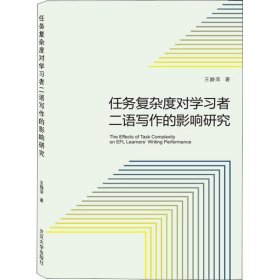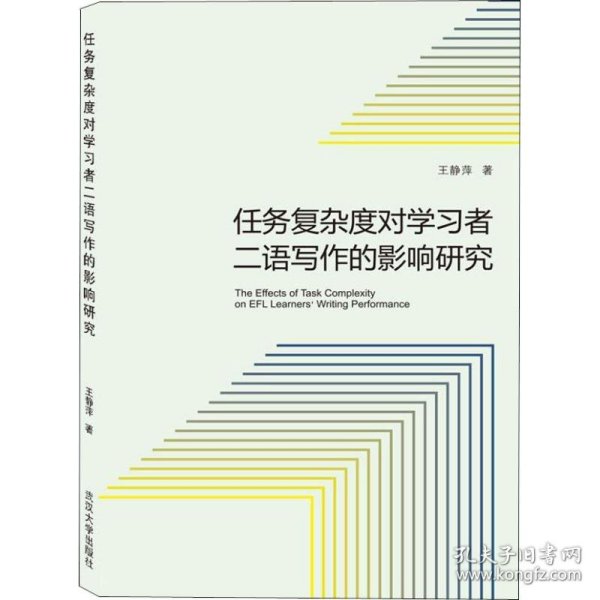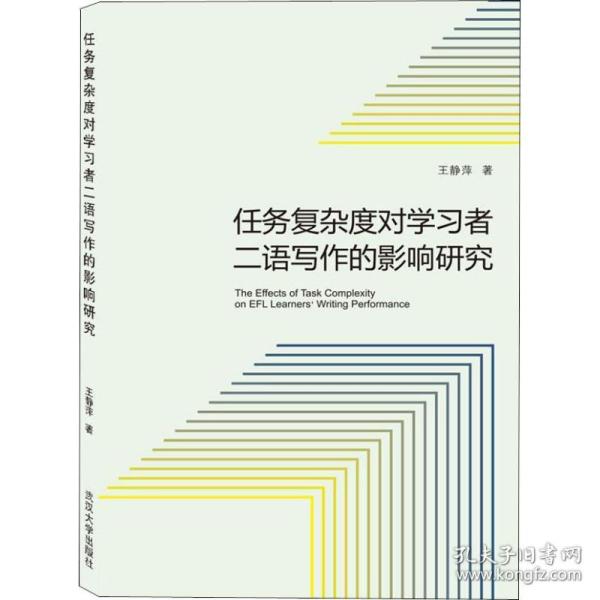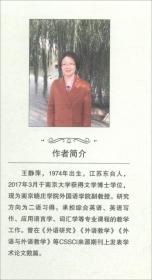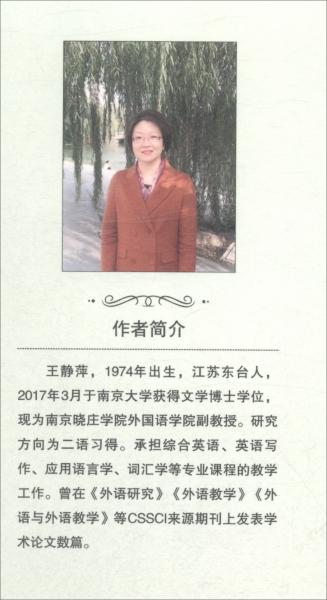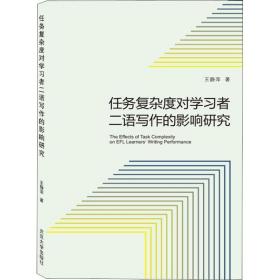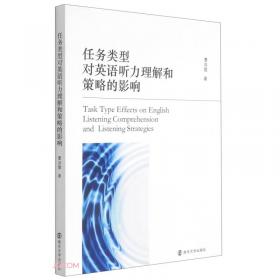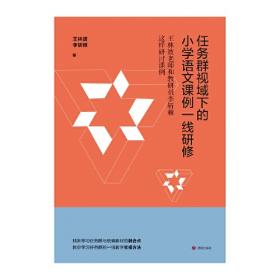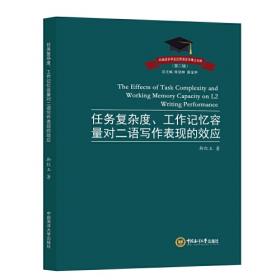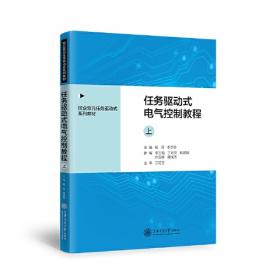任务复杂度对学习者二语写作的影响研究
出版时间:
2018-11
版次:
1
ISBN:
9787307205710
定价:
40.00
装帧:
平装
开本:
16开
纸张:
胶版纸
页数:
209页
-
《任务复杂度对学习者二语写作的影响研究》从资源指引型与资源消耗型两个维度探讨任务复杂度对二语学习者写作表现的影响。比较两个模型的预测在多大程度上切合二语写作的情况。同时,《任务复杂度对学习者二语写作的影响研究》还将学习者的二语水平作为一个因素,探讨其是否与任务复杂度对写作表现有交互影响。 王静萍,1974年出生,江苏东台人。2017年3月于南京大学获得文学博士学位。现为南京晓庄学院外国语学院副教授、执行院长。主要从事二语习得与外语教学研究。在相关学术刊物发表论文多部,出版专著和教材多部。 Chapter One Introduction
1.1 Need for the Study
1.2 Significance of the Study
1.2.1 Theoretical Significance
1.2.2 Pedagogical Significance
1.3 Overview of the Book
Chapter Two Literature Review: Related Theories
2.1 Task-based Language Teaching Approach
2.1.1 Definition of Task
2.1.2 Definition of Complexity
2.2 L1 and L2 Writing Theories
2.2.1 L1 Writing Theories
2.2.2 L2 Writing Theories
2.3 The Limited Information-processing Theory
2.4 Skehan and Foster\'s Limited Attentional Capacity Model and Robinson\'s Cognition Hypothesis
2.4.1 Skehan and Foster\'s Limited Attentional Capacity Model
2.4.2 Robinson\'s Cognition Hypothesis
2.4.3 Similarities of the Two Models
2.4.4 Differences of the Two Models
2.5 Summary
Chapter Three Literature Review: Empirical Studies
3.1 Effects of Task Complexity on Learners\' Performances Along Resource-dispersing Dimension
3.1.1 Studies on Oral Production
3.1.2 Studies on Written Production
3.2 Effects of Task Complexity on Learners\' Performances Along Resource-directing Dimension
3.2.1 Studies on Oral Production
3.2.2 Studies on Written Production
3.3 Researches Combining Both Resource-dispersing Dimension and Resource-directing Dimension
3.3.1 Studies on Oral Production
3.3.2 Studies on Written Production
3.4 Studies on L2 Writing Process
3.5 Research Gaps
Chapter Four Methodology
4.1 Research Questions
4.2 Pilot Study
4.2.1 Methods
4.2.2 Results and Discussion
4.2.3 Summary of the Pilot Study
4.3 Setting
4.4 Participants
4.5 Instruments
4.6 Data Collection
4.7 Data Analysis
4.7.1 Text Analysis of Compositions
4.7.2 Analysis of Data from the Interviews
Chapter Five Results and Discussions: Effects of Task Complexity Along Resource-directing Dimension on Written Performance
5.1 Effects of Task Complexity (±Few Elements)on Fluency
5.2 Effects of Task Complexity (±Few Elements)on Accuracy
5.3 Effects of Task Complexity (±Few Elements)on Complexity
5.4 L2 Learners\' Attention Allocated in Writing
5.5 Discussions
Chapter Six Results and Discussions: Effects of Task Complexity Along Resource-dispersing Dimension on Written Performance
6.1 Effects of Task Complexity (±Planning Time)on Fluency
6.2 Effects of Task Complexity(±Planning Time)on Accuracy
6.3 Effects of Task Complexity (±Planning Time)on Complexity
6.4 L2 Learners\' Strategy Use in and Attitudes Towards Pre-task Planning
6.4.1 Strategies Used in the Pre-task Planning
6.4.2 L2 Learners\' Attitudes Towards Pre-task Planning
6.5 Discussions
Chapter Seven Results and Discussions: Interactive Effects on Written Performance
7.1 Interactive Effects on Fluency
7.2 Interactive Effects on Accuracy
7.8 Interactive Effects on Complexity
7.4 Discussions
Chapter Eight Conclusion
8.1 Summary of Major Findings
8.2 Theoretical and Pedagogical Implications
8.2.1 Theoretical Implications
8.2.2 Pedagogical Implications
8.8 Limitations and Suggestions
Appendix IStudies Investigating the Effects of Strategic Planning on Fluency, Accuracy and Complexity
Appendix IIWriting Prompts
Appendix IIIGuidelines for T.units, Clauses, Word Counts, and Errors
Appendix IVError Classification System
References
后记
-
内容简介:
《任务复杂度对学习者二语写作的影响研究》从资源指引型与资源消耗型两个维度探讨任务复杂度对二语学习者写作表现的影响。比较两个模型的预测在多大程度上切合二语写作的情况。同时,《任务复杂度对学习者二语写作的影响研究》还将学习者的二语水平作为一个因素,探讨其是否与任务复杂度对写作表现有交互影响。
-
作者简介:
王静萍,1974年出生,江苏东台人。2017年3月于南京大学获得文学博士学位。现为南京晓庄学院外国语学院副教授、执行院长。主要从事二语习得与外语教学研究。在相关学术刊物发表论文多部,出版专著和教材多部。
-
目录:
Chapter One Introduction
1.1 Need for the Study
1.2 Significance of the Study
1.2.1 Theoretical Significance
1.2.2 Pedagogical Significance
1.3 Overview of the Book
Chapter Two Literature Review: Related Theories
2.1 Task-based Language Teaching Approach
2.1.1 Definition of Task
2.1.2 Definition of Complexity
2.2 L1 and L2 Writing Theories
2.2.1 L1 Writing Theories
2.2.2 L2 Writing Theories
2.3 The Limited Information-processing Theory
2.4 Skehan and Foster\'s Limited Attentional Capacity Model and Robinson\'s Cognition Hypothesis
2.4.1 Skehan and Foster\'s Limited Attentional Capacity Model
2.4.2 Robinson\'s Cognition Hypothesis
2.4.3 Similarities of the Two Models
2.4.4 Differences of the Two Models
2.5 Summary
Chapter Three Literature Review: Empirical Studies
3.1 Effects of Task Complexity on Learners\' Performances Along Resource-dispersing Dimension
3.1.1 Studies on Oral Production
3.1.2 Studies on Written Production
3.2 Effects of Task Complexity on Learners\' Performances Along Resource-directing Dimension
3.2.1 Studies on Oral Production
3.2.2 Studies on Written Production
3.3 Researches Combining Both Resource-dispersing Dimension and Resource-directing Dimension
3.3.1 Studies on Oral Production
3.3.2 Studies on Written Production
3.4 Studies on L2 Writing Process
3.5 Research Gaps
Chapter Four Methodology
4.1 Research Questions
4.2 Pilot Study
4.2.1 Methods
4.2.2 Results and Discussion
4.2.3 Summary of the Pilot Study
4.3 Setting
4.4 Participants
4.5 Instruments
4.6 Data Collection
4.7 Data Analysis
4.7.1 Text Analysis of Compositions
4.7.2 Analysis of Data from the Interviews
Chapter Five Results and Discussions: Effects of Task Complexity Along Resource-directing Dimension on Written Performance
5.1 Effects of Task Complexity (±Few Elements)on Fluency
5.2 Effects of Task Complexity (±Few Elements)on Accuracy
5.3 Effects of Task Complexity (±Few Elements)on Complexity
5.4 L2 Learners\' Attention Allocated in Writing
5.5 Discussions
Chapter Six Results and Discussions: Effects of Task Complexity Along Resource-dispersing Dimension on Written Performance
6.1 Effects of Task Complexity (±Planning Time)on Fluency
6.2 Effects of Task Complexity(±Planning Time)on Accuracy
6.3 Effects of Task Complexity (±Planning Time)on Complexity
6.4 L2 Learners\' Strategy Use in and Attitudes Towards Pre-task Planning
6.4.1 Strategies Used in the Pre-task Planning
6.4.2 L2 Learners\' Attitudes Towards Pre-task Planning
6.5 Discussions
Chapter Seven Results and Discussions: Interactive Effects on Written Performance
7.1 Interactive Effects on Fluency
7.2 Interactive Effects on Accuracy
7.8 Interactive Effects on Complexity
7.4 Discussions
Chapter Eight Conclusion
8.1 Summary of Major Findings
8.2 Theoretical and Pedagogical Implications
8.2.1 Theoretical Implications
8.2.2 Pedagogical Implications
8.8 Limitations and Suggestions
Appendix IStudies Investigating the Effects of Strategic Planning on Fluency, Accuracy and Complexity
Appendix IIWriting Prompts
Appendix IIIGuidelines for T.units, Clauses, Word Counts, and Errors
Appendix IVError Classification System
References
后记
查看详情
-
全新
浙江省嘉兴市
平均发货13小时
成功完成率94.37%
-
全新
浙江省嘉兴市
平均发货10小时
成功完成率94.02%
-
全新
广东省广州市
平均发货16小时
成功完成率88.33%
-
全新
广东省广州市
平均发货19小时
成功完成率88.85%
-
全新
广东省广州市
平均发货7小时
成功完成率94.43%
-
全新
浙江省嘉兴市
平均发货11小时
成功完成率92.78%
-
全新
北京市西城区
平均发货19小时
成功完成率89.02%
-
全新

 占位居中
占位居中


